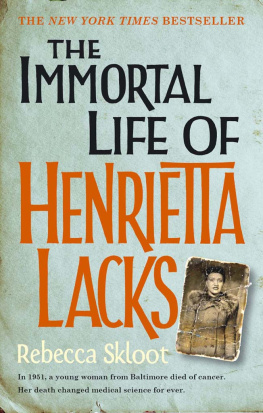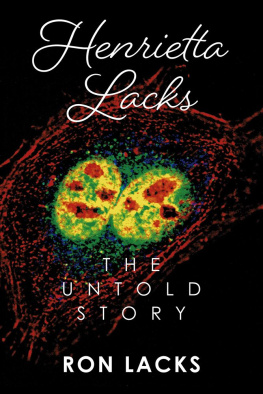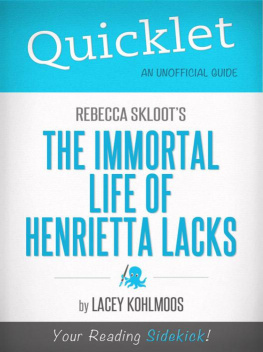Skloot - The Immortal Life of Henrietta Lacks
Here you can read online Skloot - The Immortal Life of Henrietta Lacks full text of the book (entire story) in english for free. Download pdf and epub, get meaning, cover and reviews about this ebook. year: 2010, publisher: Pan Macmillan, genre: Detective and thriller. Description of the work, (preface) as well as reviews are available. Best literature library LitArk.com created for fans of good reading and offers a wide selection of genres:
Romance novel
Science fiction
Adventure
Detective
Science
History
Home and family
Prose
Art
Politics
Computer
Non-fiction
Religion
Business
Children
Humor
Choose a favorite category and find really read worthwhile books. Enjoy immersion in the world of imagination, feel the emotions of the characters or learn something new for yourself, make an fascinating discovery.
- Book:The Immortal Life of Henrietta Lacks
- Author:
- Publisher:Pan Macmillan
- Genre:
- Year:2010
- Rating:3 / 5
- Favourites:Add to favourites
- Your mark:
- 60
- 1
- 2
- 3
- 4
- 5
The Immortal Life of Henrietta Lacks: summary, description and annotation
We offer to read an annotation, description, summary or preface (depends on what the author of the book "The Immortal Life of Henrietta Lacks" wrote himself). If you haven't found the necessary information about the book — write in the comments, we will try to find it.
Skloot: author's other books
Who wrote The Immortal Life of Henrietta Lacks? Find out the surname, the name of the author of the book and a list of all author's works by series.
The Immortal Life of Henrietta Lacks — read online for free the complete book (whole text) full work
Below is the text of the book, divided by pages. System saving the place of the last page read, allows you to conveniently read the book "The Immortal Life of Henrietta Lacks" online for free, without having to search again every time where you left off. Put a bookmark, and you can go to the page where you finished reading at any time.
Font size:
Interval:
Bookmark:

For my family:
My parents, Betsy and Floyd; their spouses, Terry and Beverly;
my brother and sister-in-law, Matt and Renee;
and my wonderful nephews, Nick and Justin.
They all did without me for far too long because of this book,
but never stopped believing in it, or me.
And in loving memory of my grandfather,
James Robert Lee (19122003),
who treasured books more than anyone Ive known.
We must not see any person as an abstraction. Instead, we must see in every person a universe with its own secrets, with its own treasures, with its own sources of anguish, and with some measure of triumph.
E LIE W IESEL
from The Nazi Doctors and the Nuremberg Code
Contents
LIFE
DEATH
IMMORTALITY
A Few Words About This Book
T his is a work of nonfiction. No names have been changed, no characters invented, no events fabricated. While writing this book, I conducted more than a thousand hours of interviews with family and friends of Henrietta Lacks, as well as with lawyers, ethicists, scientists, and journalists whove written about the Lacks family. I also relied on extensive archival photos and documents, scientific and historical research, and the personal journals of Henriettas daughter, Deborah Lacks.
Ive done my best to capture the language with which each person spoke and wrote: dialogue appears in native dialects; passages from diaries and other personal writings are quoted exactly as written. As one of Henriettas relatives said to me, If you pretty up how people spoke and change the things they said, thats dishonest. Its taking away their lives, their experiences, and their selves. In many places Ive adopted the words interviewees used to describe their worlds and experiences. In doing so, Ive used the language of their times and backgrounds, including words such as colored. Members of the Lacks family often referred to Johns Hopkins as John Hopkin, and Ive kept their usage when theyre speaking. Anything written in the first person in Deborah Lackss voice is a quote of her speaking, edited for length and occasionally clarity.
Since Henrietta Lacks died decades before I began writing this book, I relied on interviews, legal documents, and her medical records to re-create scenes from her life. In those scenes, dialogue is either deduced from the written record or quoted verbatim as it was recounted to me in an interview. Whenever possible I conducted multiple interviews with multiple sources to ensure accuracy. The extract from Henriettas medical record in chapter 1 is a summary of many disparate notations.
The word HeLa, used to refer to the cells grown from Henrietta Lackss cervix, occurs throughout the book. It is pronounced hee-lah.
About chronology: Dates for scientific research refer to when the research was conducted, not when it was published. In some cases those dates are approximate because there is no record of exact start dates. Also, because I move back and forth between multiple stories, and scientific discoveries occur over many years, there are places in the book where, for the sake of clarity, I describe scientific discoveries sequentially, even though they took place during the same general period of time.
The history of Henrietta Lacks and the HeLa cells raises important issues regarding science, ethics, race, and class; Ive done my best to present them clearly within the narrative of the Lacks story, and Ive included an afterword addressing the current legal and ethical debate surrounding tissue ownership and research. There is much more to say on all the issues, but that is beyond the scope of this book, so I will leave it for scholars and experts in the field to address. I hope readers will forgive any omissions.
PROLOGUE
The Woman in the Photograph
T heres a photo on my wall of a woman Ive never met, its left corner torn and patched together with tape. She looks straight into the camera and smiles, hands on hips, dress suit neatly pressed, lips painted deep red. Its the late 1940s and she hasnt yet reached the age of thirty. Her light brown skin is smooth, her eyes still young and playful, oblivious to the tumor growing inside hera tumor that would leave her five children motherless and change the future of medicine. Beneath the photo, a caption says her name is Henrietta Lacks, Helen Lane or Helen Larson.
No one knows who took that picture, but its appeared hundreds of times in magazines and science textbooks, on blogs and laboratory walls. Shes usually identified as Helen Lane, but often she has no name at all. Shes simply called HeLa, the code name given to the worlds first immortal human cellsher cells, cut from her cervix just months before she died.
Her real name is Henrietta Lacks.
Ive spent years staring at that photo, wondering what kind of life she led, what happened to her children, and what shed think about cells from her cervix living on foreverbought, sold, packaged, and shipped by the trillions to laboratories around the world. Ive tried to imagine how shed feel knowing that her cells went up in the first space missions to see what would happen to human cells in zero gravity, or that they helped with some of the most important advances in medicine: the polio vaccine, chemotherapy, cloning, gene mapping, in vitro fertilization. Im pretty sure that shelike most of uswould be shocked to hear that there are trillions more of her cells growing in laboratories now than there ever were in her body.
Theres no way of knowing exactly how many of Henriettas cells are alive today. One scientist estimates that if you could pile all HeLa cells ever grown onto a scale, theyd weigh more than 50 million metric tonsan inconceivable number, given that an individual cell weighs almost nothing. Another scientist calculated that if you could lay all HeLa cells ever grown end-to-end, theyd wrap around the Earth at least three times, spanning more than 350 million feet. In her prime, Henrietta herself stood only a bit over five feet tall.
I first learned about HeLa cells and the woman behind them in 1988, thirty-seven years after her death, when I was sixteen and sitting in a community college biology class. My instructor, Donald Defler, a gnomish balding man, paced at the front of the lecture hall and flipped on an overhead projector. He pointed to two diagrams that appeared on the wall behind him. They were schematics of the cell reproduction cycle, but to me they just looked like a neon-colored mess of arrows, squares, and circles with words I didnt understand, like MPF Triggering a Chain Reaction of Protein Activations.
I was a kid whod failed freshman year at the regular public high school because she never showed up. Id transferred to an alternative school that offered dream studies instead of biology, so I was taking Deflers class for high-school credit, which meant that I was sitting in a college lecture hall at sixteen with words like mitosis and kinase inhibitors flying around. I was completely lost.
Do we have to memorize everything on those diagrams? one student yelled.
Yes, Defler said, we had to memorize the diagrams, and yes, theyd be on the test, but that didnt matter right then. What he wanted us to understand was that cells are amazing things: There are about one hundred trillion of them in our bodies, each so small that several thousand could fit on the period at the end of this sentence. They make up all our tissuesmuscle, bone, bloodwhich in turn make up our organs.
Under the microscope, a cell looks a lot like a fried egg: It has a white (the cytoplasm) thats full of water and proteins to keep it fed, and a yolk (the
Next pageFont size:
Interval:
Bookmark:
Similar books «The Immortal Life of Henrietta Lacks»
Look at similar books to The Immortal Life of Henrietta Lacks. We have selected literature similar in name and meaning in the hope of providing readers with more options to find new, interesting, not yet read works.
Discussion, reviews of the book The Immortal Life of Henrietta Lacks and just readers' own opinions. Leave your comments, write what you think about the work, its meaning or the main characters. Specify what exactly you liked and what you didn't like, and why you think so.










